
Customizing a pipe rubber hose involves specifying its construction and features to perfectly match a unique application. A well-structured introduction or request to a manufacturer is crucial for getting an accurate quote and a product that performs safely and effectively.
Customizing a pipe rubber hose involves tailoring its design and manufacturing to meet specific application requirements that standard, off-the-shelf hoses cannot fulfill. This is a complex process that often requires collaboration with a specialized manufacturer.
Before even thinking about materials or manufacturing, you need a clear understanding of what the hose needs to do. A common mnemonic for this is S.T.A.M.P.E.D.
S - Size:
Inner Diameter (ID): Crucial for flow rate. The ID of the hose should ideally match the outer diameter (OD) of the pipe or fitting it connects to for an accurate fit and to minimize leaks.
Outer Diameter (OD): Important for space constraints and external fittings.
Length: Ensure it's long enough to reach connections without being stretched, but not so long that it kinks or rubs against other components.
Bend Radius: The minimum radius the hose can bend without kinking or damaging its structure. This is critical for routing in tight spaces.
T - Temperature:
Operating Temperature Range: The minimum and maximum temperatures the fluid passing through the hose will experience, as well as the ambient temperature of the environment. Different rubber compounds have varying temperature resistances (e.g., EPDM for high heat, silicone for extreme temperatures).
A - Application:
What is the hose being used for? (e.g., automotive cooling, industrial fluid transfer, agricultural machinery, hydraulic systems, air intake).
Are there specific movements, vibrations, or external forces the hose will encounter?
Does it need to be resistant to abrasion, ozone, UV, or other environmental factors?
M - Media & Material:
Media (Fluid/Gas): What fluid or gas will the hose convey? This is paramount for selecting the correct inner tube material to ensure chemical compatibility and prevent degradation. Examples include water, oil, fuel, chemicals, air, etc.
Material:
Inner Tube: Must be compatible with the media. Common options include natural rubber, synthetic rubber (like Nitrile for oil/fuel, EPDM for heat/ozone, Silicone for extreme temps and sanitary applications), or even fluoropolymers for high chemical inertness.
Reinforcement Layer: Provides strength and pressure resistance. Can be textile fibers (polyester, nylon, aramid), steel wire (braided or spiraled), or a combination.
The configuration (braided, spiraled, knitted) affects pressure capabilities and flexibility.
Outer Cover: Protects the reinforcement layer from external damage, abrasion, environmental factors (ozone, UV), and sometimes provides color-coding.
P - Pressure:
Working Pressure: The continuous pressure the hose will operate under.
Burst Pressure: The maximum pressure the hose can withstand before failure.
Vacuum Resistance: If the hose operates under negative pressure (suction), it needs to be designed to resist collapse.
Impulse Pressure: Consider pressure spikes or fluctuations in the system, as these can significantly de-rate a hose's effective pressure rating.
E - Ends (Fittings):
What type of end fittings are required to connect the hose to your system? (e.g., threaded, flanged, quick disconnect, crimped, reusable).
The fittings must be compatible with the hose material and the application's pressure and temperature requirements. Built-in nipples can offer secure connections and full flow.
D - Delivery (Quantity & Lead Time):
How many hoses do you need? Custom orders often have minimum order quantities.
What is your desired lead time for production and delivery?
Once you have your requirements clearly defined, you'll work with the manufacturer's design team. This phase involves:
Detailed Drawings/Specifications: Providing precise dimensions, shapes (e.g., 45-degree bends, U-shaped configurations), tolerances, and all the information gathered from the S.T.A.M.P.E.D. analysis.
Material Selection: The manufacturer will help you finalize the specific rubber compounds and reinforcement materials based on your application and performance needs.
Construction Method: The chosen design will influence the manufacturing method. Common methods include:
Extrusion: For continuous tubes (inner or outer layers).
Mandrel-Formed/Hand-Built: For complex shapes, precise internal diameters, or larger hoses. The rubber is built up around a mandrel (a shaped core).
Spiral Wrapping/Braiding/Knitting: For applying reinforcement layers.
Molding: For integrating multiple components into a single unit.
Prototyping: For complex or critical applications, a prototype will often be created and tested before full-scale production.
While the specifics vary by manufacturer and hose type, the general steps for rubber hose manufacturing include:
Material Preparation: Mixing and compounding raw rubber with various additives (curing agents, fillers, etc.) to achieve desired properties.
Inner Tube Extrusion/Forming: Shaping the inner layer of the hose.
Reinforcement Layer Application: Applying fabric or wire reinforcement layers.
Outer Cover Application: Applying the protective outer layer.
Vulcanization/Curing: Heating the hose under pressure to cross-link the rubber molecules, giving it its final strength, durability, and elasticity.
Trimming and Finishing: Removing excess material, cutting to length, and sometimes attaching end fittings.
Quality Control: Rigorous testing (pressure, temperature, burst, vacuum, dimensional accuracy) to ensure the hose meets all specifications.
Expert Consultation: Work closely with experienced rubber hose manufacturers or engineers. Their expertise is invaluable for material selection, design optimization, and manufacturing feasibility.
Cost vs. Performance: Custom hoses can have a higher initial cost than standard hoses, but they can offer significant long-term savings by improving efficiency, reducing leaks, and minimizing maintenance and replacement needs.
Testing: Comprehensive testing is crucial to validate the custom hose's performance under simulated real-world conditions.
Tolerance: Be realistic about the tolerances required for your application. Tighter tolerances can increase manufacturing complexity and cost.
By carefully considering all these factors and collaborating with a knowledgeable manufacturer, you can successfully customize a pipe rubber hose to meet the unique demands of your application.
